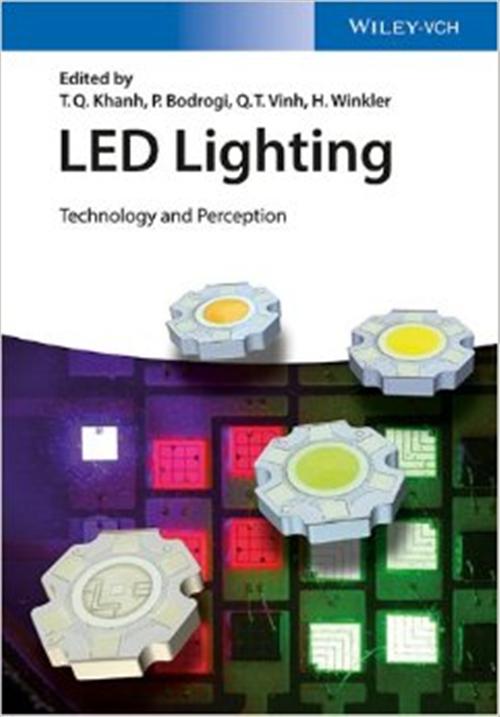LED Lighting: Technology and Perception [2015-08-04] |
|
索书号 TM923/K45 目录Foreword V Table of the Coauthors XIX Preface XXI 1 Introduction 1 2 The Human Visual System and Its Modeling for Lighting Engineering 7 2.1 Visual System Basics 7 2.2 Radiometry and Photometry 16 2.3 Colorimetry and Color Science 22 2.4 LED Specific Spectral and Colorimetric Quantities 41 2.5 Circadian Effect of Electromagnetic Radiation 44 3 LED Components – Principles of Radiation Generation and Packaging 49 3.1 Introduction to LED Technology 49 3.2 Basic Knowledge on Color Semiconductor LEDs 50 3.3 Color Semiconductor LEDs 67 3.4 Phosphor Systems and White Phosphor-Converted LEDs 72 3.5 Green and Red Phosphor-Converted LEDs 109 3.6 Optimization of LED Chip-Packaging Technology 118 4 Measurement and Modeling of the LED Light Source 133 4.1 LED Radiometry, Photometry, and Colorimetry 133 4.2 Thermal and Electric Behavior of Color Semiconductor LEDs 143 4.3 Thermal and Electric Behavior of White Phosphor-Converted LEDs 149 4.4 Consequences for LED Selection Under Real Operation Conditions 157 4.5 LED Electrical Model 160 4.6 LED Spectral Model 167 4.7 Thermal Relationships and Thermal LED Models 181 4.8 Measurement Methods to Determine theThermal Characteristics of LED Devices 190 4.9 Thermal and Optical Behavior of Blue LEDs, Silicon Systems, and Phosphor Systems 197 4.10 Aging Behavior of High-Power LED Components 201 4.11 Lifetime Extrapolation 214 4.12 LED Dimming Behavior 222 5 Photopic Perceptual Aspects of LED Lighting 233 5.1 Introduction to the Different Aspects of Light and Color Quality 233 5.2 Color Rendering Indices: CRI, CRI2012 242 5.3 Semantic Interpretation of Color Differences and Color Rendering Indices 253 5.4 Object Specific Color Rendering Indices of CurrentWhite LED Light Sources 261 5.5 Color Preference Assessment: Comparisons Between CRI, CRI2012, and CQS 273 5.6 Brightness, Chromatic Lightness, and Color Rendering of White LEDs 285 5.7 White Point Characteristics of LED Lighting 292 5.8 Chromaticity Binning of White LEDs 298 5.9 Visual Experiments (Real Field Tests) on the Color Quality of White LEDs 309 5.10 Circadian Stimulus, Color Temperature, and Color Rendering of White LEDs 315 5.11 Flicker and Stroboscopic Perception of White LEDs under Photopic Conditions 321 6 Mesopic Perceptual Aspects of LED Lighting 337 6.1 Foundations and Models of Mesopic Brightness and Visual Performance 337 6.2 Mesopic Brightness under LED Based and Conventional Automotive Front Lighting Light Sources 347 6.3 Mesopic Visual Performance under LED Lighting Conditions 353 6.4 Visual Acuity in the Mesopic Range with Conventional Light Sources and White LEDs 357 6.5 Detection and Conspicuity of Road Markings in the Mesopic Range 362 6.6 Glare under Mesopic Conditions 368 6.7 Bead String Artifact of PWMControlled LED Rear Lights at Different Frequencies 388 6.8 Summarizing Remarks to Chapter 6 394 7 Optimization and Characterization of LED Luminaires for Indoor Lighting 399 7.1 Indoor Lighting – Application Fields and Requirements 399 7.2 Basic Aspects of LED-Indoor Luminaire Design 403 7.3 Selection Criteria for LED Components and Units 409 7.4 Application Fields with Higher Color and Lighting Requirements 414 7.5 Principles of LED Radiation Generation with Higher Color Quality and One Correlated Color Temperature 421 7.6 Optimization and Stabilization of Hybrid LED Luminaires with High Color Rendering Index and Variable Correlated Color Temperature 426 8 Optimization and Characterization of LED Luminaires for Outdoor Lighting 443 8.1 Introduction 443 8.2 Construction Principles of LED Luminaire Units 445 8.3 Systematic Approach of LED Luminaire Design for Street Lighting 451 8.4 Degradation Behavior of LED Street Luminaires 460 8.5 Maintenance Factor for LED Luminaires 463 8.6 Planning and Realization Principles for New LED Installations 471 9 Summary 479 Index 483
|
首 页 >> 上架新书






